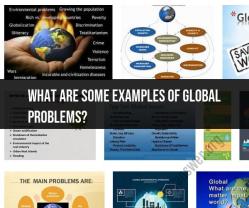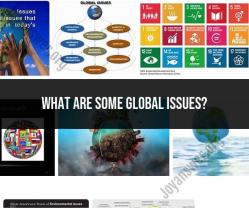What makes a problem a global problem?
A problem is considered a global problem when it exhibits certain characteristics that transcend national borders and impact multiple countries and regions simultaneously. These characteristics help distinguish global problems from more localized or national issues. Here are some key characteristics of global problems:
Cross-Border Impact: Global problems do not respect national boundaries; they affect multiple countries and regions. The consequences of these problems can spread across borders, making them a shared concern.
Interconnectedness: Global problems often have complex and interconnected causes and effects. Multiple factors and actors contribute to the problem, and addressing it requires understanding these interdependencies.
Scale and Magnitude: Global problems tend to be of significant scale and magnitude. They affect large populations, ecosystems, or economies and have far-reaching implications.
Transnational Nature: Global problems are transnational in nature, meaning they involve actors, organizations, or elements that operate beyond the jurisdiction of any single nation. This can include international corporations, non-governmental organizations, and global supply chains.
Global Awareness: These problems are recognized on a global scale, and there is a shared awareness of their existence and potential consequences. International media coverage and discussions often highlight global problems.
International Cooperation: Addressing global problems requires international cooperation and collaboration among countries, organizations, and stakeholders. Solutions often necessitate coordinated efforts at the global level.
Global Consequences: Global problems have consequences that extend beyond the affected regions. These consequences can include economic impacts, health and environmental risks, and security threats.
Long-Term Impact: Many global problems have long-term and enduring effects, making them persistent challenges that require sustained attention and action.
Complexity: Global problems are often complex and multifaceted, involving social, economic, political, environmental, and technological dimensions. Solutions may require comprehensive approaches.
Global Governance and Policies: Addressing global problems often involves the development and implementation of international policies, agreements, and regulations. Global governance mechanisms may be established to manage these issues.
Examples of global problems that exhibit these characteristics include climate change, pandemics, terrorism, human trafficking, cyber threats, and nuclear proliferation. These issues transcend individual countries and necessitate global cooperation and concerted efforts to mitigate their impacts and find sustainable solutions.
It's important to note that not all global problems are equally urgent or require the same level of international attention, but they all share these fundamental characteristics that make them global in nature.
- Identifying Global Problems: What Makes an Issue Global
An issue is considered global if it affects people all over the world, regardless of their country, ethnicity, or socioeconomic status. Global problems are often complex and interconnected, and they can have a significant impact on human health, the environment, and the global economy.
Some of the factors that make an issue global include:
- Scale: The issue affects a large number of people in different countries around the world.
- Impact: The issue has a significant impact on human health, the environment, or the global economy.
- Interconnectedness: The issue is interconnected with other global problems.
- Urgency: The issue needs to be addressed urgently in order to avoid serious consequences.
Some examples of global problems include:
- Climate change
- Poverty and inequality
- Hunger and malnutrition
- Disease
- Conflict and violence
- Environmental degradation
- Global Challenges: Criteria for Defining a Problem as Global
There is no single definition of a global problem, but there are a number of criteria that can be used to assess whether or not an issue is global. These criteria include:
- Scale: The issue affects a large number of people in different countries around the world.
- Impact: The issue has a significant impact on human health, the environment, or the global economy.
- Interconnectedness: The issue is interconnected with other global problems.
- Urgency: The issue needs to be addressed urgently in order to avoid serious consequences.
In addition to these criteria, it is also important to consider the following factors when defining a problem as global:
- Reversibility: Is the problem reversible, or is it likely to have permanent consequences?
- Equity: Does the problem disproportionately affect certain groups of people?
- Justice: Is the problem the result of injustice or inequality?
- The Globalization of Problems: Understanding Their Widespread Impact
The globalization of problems refers to the process by which problems that were once local or regional in scope have become global in scope. This is due to a number of factors, including increased trade and travel, the spread of technology, and the interconnectedness of the global economy.
The globalization of problems has a number of implications. First, it means that problems that once affected only a small number of people can now have a significant impact on people all over the world. Second, it means that problems that were once relatively easy to address can now be more difficult to address, due to the complex and interconnected nature of global problems.
It is important to understand the globalization of problems in order to develop effective solutions. Global problems require global solutions, and these solutions must be developed with the participation of all stakeholders.
Here are some examples of how the globalization of problems has had a widespread impact:
- The COVID-19 pandemic has shown how quickly a disease can spread around the world, and how it can have a devastating impact on people and economies everywhere.
- The climate crisis is another example of a global problem that is having a widespread impact. Climate change is already causing more extreme weather events, rising sea levels, and changes in plant and animal life.
- The war in Ukraine is another example of a global problem that is having a widespread impact. The war has caused a humanitarian crisis in Ukraine, and it has also had a significant impact on the global economy, including rising food and energy prices.
These are just a few examples of how the globalization of problems is having a widespread impact on the world. It is important to understand these problems and to work together to develop solutions.





